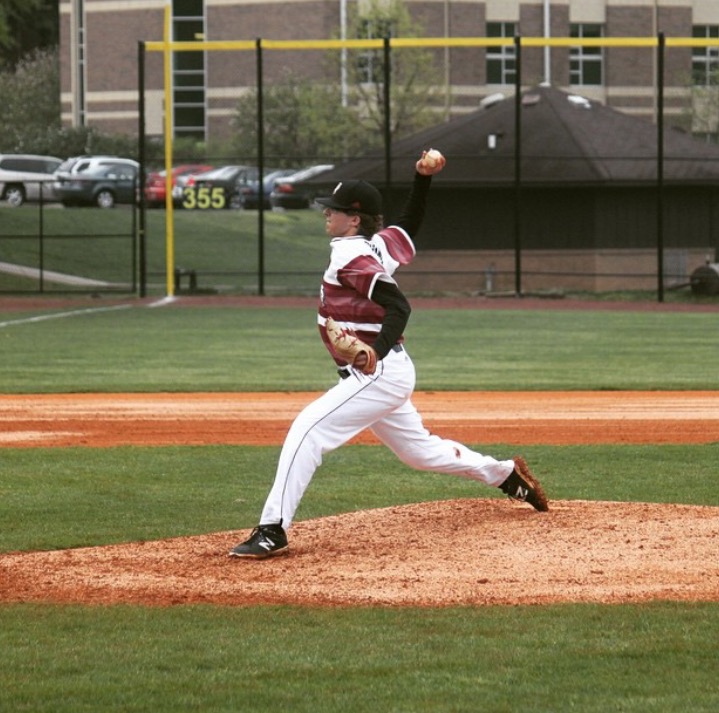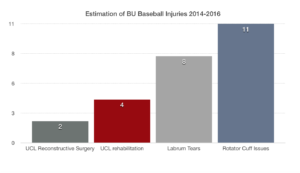By Mary Ringwald, Staff Writer
Five lone chairs sit to the left of the Bellarmine University baseball dugout. They may seem like an anomaly, but they have a purpose. One by one, a few members of the team sit in those chairs after collecting loose balls and moving equipment. Each player thinks he should be throwing, but the scars and slings prevent any of them from joining the warm-up routine.
Injuries are inevitable in collegiate sports, but they are more common for baseball pitchers than throwing a no-hitter. Throughout the 2016 season, Bellarmine has eight players on the disabled list, including five pitchers.
The words “Tommy John surgery” have become three of the most feared words of a pitcher’s career because the surgery is not uncommon.
In the last two seasons, two Bellarmine pitchers have had surgeries to repair and reconstruct the ulnar collateral ligament through arthroscopic surgery, which is a procedure that allows an orthopedic surgeon to repair the ligament through a telescope inserted into the joint by a small incision.
According to a 2011 study by the American Journal of Sports Medicine, the average amount of Tommy John surgeries per year has steadily increased for ages 15 to 24 since 2007. While the surgery has become more prevalent in the last 10 years, a variety of arm injuries continue to plague college baseball pitchers.
In the Knights’ last two seasons, the sources in Bellarmine Office of Sports Medicine estimate pitchers have suffered at least two ulnar collateral ligament reconstructive surgeries, four necessary UCL rehabilitations, eight labrum tears and 11 rotator cuff injuries.
Bellarmine University head athletic trainer Brad Bluestone worked in professional baseball with the St. Louis Cardinals for 13 years. He said he has seen a higher number of injuries with his college athletes compared to his professional clients.
“You have got kids bouncing from coach to coach and team to team and there is no continuity,” Bluestone said. “There is no concept of rest, and it is just a lack of looking at them at an annual basis on a holistic level. I have gone back and forth with theories, but I have really put a lot of weight on how they are flat out not getting the recovery time that they need.”
The problem with overuse
Bellarmine left-handed pitcher Willie Poe sat patiently outside the bullpen waiting for his coach to say, “get hot.” He would throw 15 to 20 warm-up pitches before getting the signal to take the mound.
The waiting was an adjustment for the former Lexington Catholic High School starting pitcher. He said in high school he always knew when he was going to throw, but as a relief pitcher, he had to change his whole routine.
“It’s just so different,” Poe said. “Being a reliever takes much more body awareness to know when to not go all out because your arm is sore or something. Being a freshman, I went all out every time and I think it really took a toll on me.”
Now a sophomore, Poe has undergone surgery to remove a bone spur and repair cartilage in his left elbow and examine a possible tear in his ulnar collateral ligament in his pitching arm. “When they did the surgery, they went in there and looked to make sure that my UCL was not stretched out and make sure it was not partially torn or anything, and it wasn’t,” Poe said. “Now, they think it was a combo of genetics and overuse thought the years.”
According to the American Sports Medicine Institute, youth baseball pitchers should not pitch more than 100 innings in a calendar year and take at least two to three months rest from competitive pitching.
Orthopedic surgeon Dr. Walter E. Badenhausen has worked with nearly a dozen colleges and professional sports teams throughout his career. He said overtraining has increased with the addition of year-round baseball teams.
“Overtraining and specializing in one sport, which only involves training one set of muscles specific for that sport, means the other muscles are forgotten,” Badenhausen said. “You get overtrained bodies because of the expectation that every guy is either the next Michael Jordan or the next pitcher in the National League. It becomes a work problem.”
Early specialization is just one of four problems that contribute to overuse in a baseball pitcher. Young pitchers also continually pitch while fatigued, throw competitive pitches too soon and face extensive pressure from parents and coaches.
Starting kids too young
The competitiveness of youth baseball keeps growing at a rapid pace. AAU baseball more than 50 districts with hundreds of tournaments regionally and nationally throughout the entire year for ages under-8 to under-19.
The increased number of competitive games makes young pitchers more susceptible to overuse when a pitcher is fatigued.
Bellarmine head baseball coach Larry Owens said pitchers throwing when tired is one of the highest causes of injury in youth baseball.
“They can throw fatigued as a 10-year-old in a tournament, and they are throwing twice a day two days in a row,” Owens said. “ Other things like maximum effort, radar guns, playing on multiple teams, and pitching and catching can all lead to arm injuries.”
The American Journal of Sports Medicine conducted a study in 2002 that showed a significant relationship between the number of pitches thrown and the amount of pain in a youth pitcher’s arm. The study said youth pitchers who threw curveballs or sliders had an increased risk of injury due to overuse and fatigue.
Fatigue can occur from pitching too many times in a row on a given day or weekend. Coaches should be on the lookout for the early warning signs such as a noticeable drop in velocity, a dropped elbow in between pitches or taking increased time between pitches.
Owens said that many high school and college coaches receive “damaged goods” because pitchers are playing or coming into programs with arm injuries.
“If they are strong enough to overcome it and their velocity is good, they get opportunities later on,” Owens said. “If they don’t overcome it, then I think they will end up hurting themselves and I think that is what you see.”
Recognizing fatigue is half the battle, but for some parents and coaches, rest does not seem like an option.
The early introduction of specialized pitches can cause issues because adolescent growth plates at the origin of the ulnar collateral ligament cannot safely withstand the increased strain of complex pitches.
It is important for young players to learn a fastball before moving into a change-up, curveball or slider.
Junior right-hander Zach Williams underwent two arm surgeries during his college career. He had Tommy John surgery his freshman year and surgery to repair a frayed labrum in April. He said it is important for young pitchers and their parents to focus on development before the players throw complex pitches.
“Parents get caught up in the moment and are so worried about having their kid be the greatest at a young age,” Williams said. “Development is very important. There are leagues that are implementing no curveballs until certain age limits, such as 13 and older, and this is tremendous. Putting the kid’s future first is what the focus needs to be on and by placing restrictions on certain pitches, can only prolong their careers.”
Bluestone said that many youth coaches and parents are more concerned about winning games instead of the teaching of basic pitching skills.
“Everybody and their brother thinks they can coach a baseball team,” Bluestone said. “You have some really good coaches out there who have the kids best interests at heart, but the focus should be less on winning games and tournaments and more on skill, practice and strength developments. I think that is sorely lacking, and it has a big part in what is going on.”
It’s all in the biomechanics
Windup, pivot, step, release and follow through. These five steps can define the basics of pitching, but there is more to pitching that just throwing a baseball.
The basis of all sports lies in the biomechanics, or the study of human movements. A pitcher’s range of arm motion, body rotation and follow through all have a significant impact on the velocity and speed of the ball.
In 2009, the American Sports Medicine Institute said the study of baseball pitching mechanics should be rooted in the development of youth pitchers from the time they first pick up a baseball through high school.
“When you talk about pitching, you need to teach players how to pitch fast, slow, inside, outside, up and down for them to be successful pitcher,” Bellarmine athletic director Scott Wiegandt said. “For every repetition and every pitch you throw, you should be training your arm twice in the opposite direction because of the decelerating muscles of your rotator cuff.”
Wiegandt achieved All-American honors as the Knights’ senior pitcher in 1989 and he continued his baseball career at the professional level for 10 years with the Philadelphia Phillies, St. Louis Cardinals and Pittsburgh Pirates. He pitched at the AA and AAA levels until his career ended with a severe knee injury.
He made sure to take care of his pitching arm by practicing the fundamentals, and it was the main reason why he played baseball for over 20 years.
“There is a difference between a thrower and a pitcher,” Wiegandt said. “A lot of the times, a thrower will light up the radar gun, but they did not become a pitcher until their first injury.”
Pitching is an art form that involves more than the extension of the arm. It also involves core strength, the stride of the leg off the mound and a full-body follow through that increases the ball’s velocity.
“Everybody’s mechanics are slightly different and you are never going to make a cookie-cutter pitcher,” Bluestone said. “You have a general form of what you want them to do and what you want them to look like, but you cannot predict and fix everything.”
Coaches can make suggestions to change a pitcher’s delivery for them to throw safely and effectively. While the instruction comes from the coaches, the changes have to come from the pitchers themselves.
“Change is tough because they may not want to change it,” Owens said. “If they don’t want to change it, then they wont change it.”
A player should listen to the advice given by coaches and trainers to prevent injury and make necessary changes to save his pitching arm.
“You have to break bad habit and create new and safer ones and do what you need to do to protect your arm,” Wiegandt said. “When athletes come back from injury, the doctors, training staff and sports medicine all release them, but the athlete, in their own mind, is the last to release an athlete from injury.”
The great thing about patience
Sophomore Eddie Mathis stands behind a net in the outfield during practice. Balls are rolled through the freshly cut grass toward a bag that lies to the right of his feet. He starts to throw the ball against the net, but he doesn’t.
The left-handed pitcher and freshman standout has been in recovery for a whole season after his Tommy John surgery last summer.
“The recovery process has been going very well, even if it has been a long and tough process,” Mathis said. “I had physical therapy the day after I had surgery to see how much range of motion I already had. For the next two months, I worked on getting the range of motion back in my elbow, which is the most pain I have ever experienced.”
But the pain is a feeling of the past. His patience paid off when his first round of throwing exercises came at the end of the season.
The word patience may seem redundant in the world of sports medicine, but it is the most important step on the road to the recovery of a sports-related injury. Trainers, orthopedic surgeons and coaches encourage their injured players not to rush their rehab exercises.
“The definition of insanity is doing the same thing over and over again expecting a different result,” Bluestone said. “I strongly believe that when athletes come back throwing better than they did before it is a function of the rehab they have done and strengthening the weak links in the body before the injury occurred.”
Bellarmine sports psychology professor Dr. Ann Jirkovsky said fear can play a major role in whether the athlete will return to the game with the same mentality they had before their injury.
“For athletes who really identify with their sport, when they get injured, there is a lot of fear over if they are going to get to play again and if they will be back at the level they were at or if their injury is career ending,” Jirkovsky said.
It takes a surge of mental toughness and a complete love of the game to make it through the hours of rehab and watching teammates practice.
After Mathis and Williams had their Tommy John surgeries, they were both disappointed and felt like they were letting their teammates down when they could have helped them succeed. But the disappointment was not worth giving up the game completely.
“I played college baseball because I absolutely love the game,” Mathis said. “I have been playing for so long that it would have been weird not to play. I plan on trying to play baseball as long as I can because unfortunately I won’t be able to play for the rest of my life.”
Williams said rehab can be tough, but injured pitchers should not give up and stay strong mentally throughout the whole process.
“Stay the course,” Williams said. “Physically, it can be tough on your body, but the most important part is the mental aspect especially in rehabs that are six-plus months long where it is easy to lose focus. Take it day by day and those days will eventually add up.”
When the days add up, the five chairs near the Bellarmine dugout will be empty. One by one, each pitcher will recover from his months of long rehab, and his scars will only serve as reminders of his patience.
The purpose of the chairs will have served their time, and in the future, they will lie empty as those injured pitchers throw their first strikeouts on Knights field.
This chart is an estimation of Bellarmine baseball injuries from 2014 to 2016.
Willie Poe waits for the catcher’s signal. Photo courtesy of Willie Poe.



